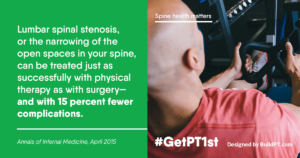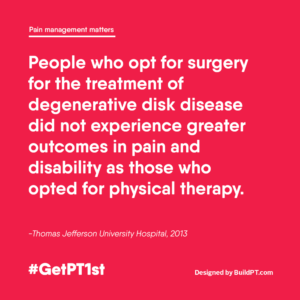Sciatica
Low Back Pain
Sciatica is a generic term for lower back pain, which can be the result of many issues, including:
- Annular Tears (in the discs between your vertebrae)
- Internal Disc Disruption (disc changes)
- Herniated Disc (slipped or ruptured disc)
- Facet Joint Arthritis (in stabilizing joints)
- Segmental Instability (too much movement between vertebrae)
- Spinal Stenosis (lumbar nerve compression)
- Foraminal Stenosis (spinal nerve root compression)
The Registered Physiotherapists at Focus Physiotherapy are trained to determine the root cause of your Sciatica, and provide individualized treatment programs to help you achieve the best possible physical recovery so you can return to normal activities.
Disc Herniation
Prolapsed/Ruptured Disc
Disc Herniation happens when the central material of one of your spinal discs is squeezed out of your lumbar vertebrae. It’s a condition that can be painful, especially if the squeezed material starts to press on nearby nerves.
The level of pain you experience as a result of Disc Herniation is not always in proportion with the size of the hernia. Some people with significant Disc Herniation can have excellent outcomes, and avoid surgery altogether, by participating in an individualized physical therapy program.
Our Registered Physiotherapists can identify what is most likely to be beneficial for your recovery, and create a program that reduces stress on the spine while relieving pain and discomfort during activities. Our treatment solutions for Disc Herniation, which include the use of specialized physiotherapy equipment, will take into account your unique lifestyle demands.
Degenerative Disc Disease (DDD)
Disc Deterioration
As we age, the discs in our spine compress and lose height, which means we become shorter. If this loss of height results in pain, the cause is described as Degenerative Disc Disease, which presents in the form of pains, weakness and burning sensations. DDD, however, is not something to be feared. It’s not really a disease, and doesn’t necessarily get worse over time. It’s a condition that our team treats frequently, and we have developed assessments to quickly identify aggravating factors and suggest programs to alleviate painful areas effectively.
We also actively involve you, the patient, in your treatment program, with strengthening exercises to complete at home. Unlike other interventions, Physiotherapy can result in long-term quality-of-life improvements.
Our interventions and education packages will help you create lifelong habits to prevent future flare-ups and increase the enjoyment of activities that had become painful.
People who opt for surgery for the treatment of degenerative disc disease did not experience greater outcomes in pain and disability as those who opted for physiotherapy
Spinal Stenosis
Pinched Nerves
When our Registered Physiotherapists see a patient with Spinal Stenosis, the diagnosis has usually been made as a result of an X-Ray, CT scan or MRI that indicates a narrowing of the spinal canal. Many people who come to see us for an assessment don’t understand the cause of their pain, or why they are experiencing such severe symptoms.
Spinal Stenosis is a degenerative process involving a shrinking spinal canal that compresses and irritates the spinal column. Spinal Stenosis can be congenital, or can be due to degeneration, instability or disc herniation. The symptoms you experience—such as back pain, problems with your feet, shooting pains or cramping in your legs—are due to this pinching around the spinal column.
Many patients who experience severe low back pains such as Spinal Stenosis never require surgery if they have well-timed physiotherapy treatment.
 Lumbar spinal stenosis, or the narrowing of the open spaces in your spine, can be treated just as successfully with physiotherapy as with surgery, and with 15% fewer complications!
Lumbar spinal stenosis, or the narrowing of the open spaces in your spine, can be treated just as successfully with physiotherapy as with surgery, and with 15% fewer complications!
Spondylosis
Osteoarthritis
Years of poor posture can take a toll on your spine. Abnormal vertebral wear and tear that causes unusual formations, such as bone spurs, is often the result of repeated detrimental activities or irregular weight bearing throughout the spine. The painful result can be pinching of the nerves and nerve roots, which causes shooting pains and numbness in the body’s extremities.
The purpose of conservative treatment programs is to avoid the need for radical medical intervention or surgery. Physiotherapy treatment is just such a program, and has been shown to be very effective for the relief of Spondylosis. Post-physiotherapy, patients often report quality-of-life changes. Left untreated, Spondylosis can be a precursor to the painful condition of Spondylolisthesis, which means that early attention is advisable.
Spondylosis should not be confused with Spondylolysis, which is typically caused by an undisplaced stress fracture to a specific part of the facet joint called the pars interarticularis (Pars), causing possible vertebra instability.
Spondylolisthesis
Displaced Vertebrae
Where a vertebra has deteriorated to the point that it has displaced, or slipped forward, and can potentially press on spinal-column nerves, the resulting condition is called Spondylolisthesis. It’s a serious condition, but can be treated effectively with physiotherapy. Before starting physical therapy, your Spondylolisthesis must be stable. By reviewing your medical records and diagnostic tests, our team of Registered Physiotherapists will ascertain the degree of displacement, to determine the best course of action to promote recovery and a return to function.
By working with a specialized, registered health practitioner, you can be confident of a safe recovery.f



